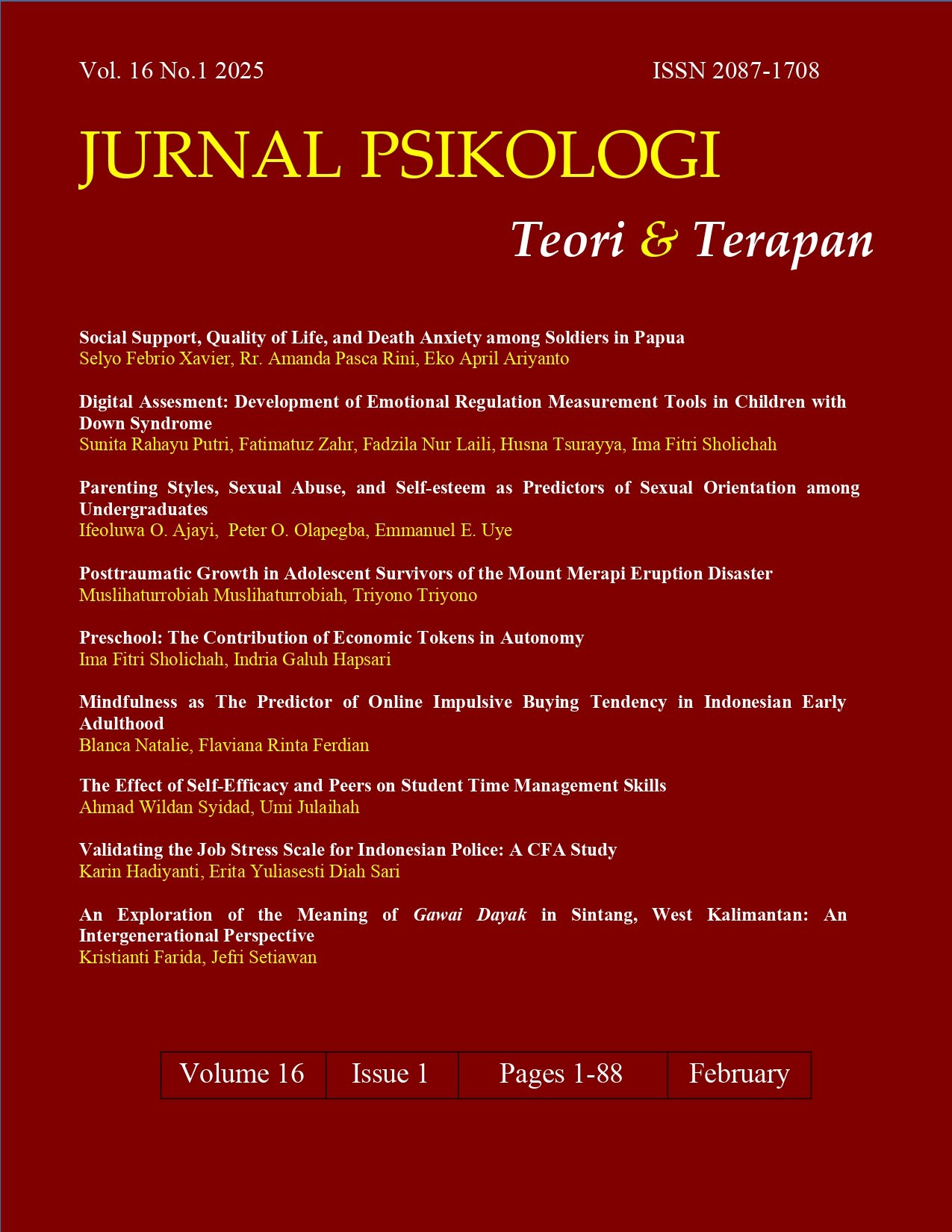Mindfulness as The Predictor of Online Impulsive Buying Tendency in Indonesian Early Adulthood
DOI:
https://doi.org/10.26740/jptt.v16n01.p46-56Keywords:
Early adult, mindfulness, online impulsive buying tendencyAbstract
Background: Online shopping attracts early adults (ages 20-39) due to price, convenience, time efficiency, etc, who are trying to regulate their shopping activities, and mindfulness is one approach can help individuals be aware of shopping behavior, avoiding impulsive buying. Objective: This study aims to examine whether mindfulness can significantly predict online impulsive buying tendency in early adults by using simple linear regression analysis, with early adults respondents (ages 20-39). Method: Research is using quantitative correlational design, and Pearson Correlation is used for analysis. Data (n=487) were collected using convenience sampling through online questionnaire containing Mindfulness Attention and Awareness Scale (MAAS-15) and Impulsive Buying Tendency Scale in the online shopping context (IBTS-20). Result: The results of the statistical analysis indicate mindfulness significantly and negatively predict online impulsive buying tendency in early adults. Additional analysis reveals a difference in the levels of females and males online impulsive buying tendency, with females scoring higher than males. Conclusion: Mindfulness predicts online impulsive buying tendency. Suggestion: Future research is suggested to explore other factors influence online impulsive buying tendency.
Keywords: Early adult; mindfulness; online impulsive buying tendency.
Abstrak
Latar Belakang: Belanja online menarik perhatian dewasa awal (usia 20-39 tahun) karena faktor harga, kenyamanan, efisiensi waktu, dan lainnya. Mereka berusaha mengatur aktivitas belanja, dan mindfulness menjadi contoh pendekatan yang dapat membantu menyadari perilaku belanja mereka serta menghindari pembelian impulsif. Tujuan: Penelitian ini bertujuan untuk menguji apakah mindfulness dapat memprediksi kecenderungan pembelian impulsif online secara signifikan pada dewasa awal. Penelitian ini menggunakan metode kuantitatif dengan analisis regresi linier sederhana, dengan responden dewasa awal (usia 20-39 tahun). Metode: Penelitian ini menggunakan desain kuantitatif korelasional, dan analisis dilakukan dengan menggunakan Korelasi Pearson. Data (n=487) dikumpulkan menggunakan metode convenience sampling melalui kuesioner online berisi Mindfulness Attention and Awareness Scale (MAAS-15) dan Impulsive Buying Tendency Scale dalam konteks belanja online (IBTS-20). Hasil: Hasil analisis statistik menjelaskan mindfulness dapat secara signifikan dan negatif memprediksi kecenderungan pembelian impulsif online pada dewasa awal. Analisis tambahan menunjukkan perbedaan tingkat kecenderungan pembelian impulsif online antara perempuan dan laki-laki, dengan skor lebih tinggi pada perempuan. Kesimpulan: Mindfulness memprediksi pembelian impulsif online Saran: Penelitian selanjutnya disarankan untuk mengeksplorasi faktor-faktor lain yang mempengaruhi kecenderungan pembelian impulsif online.
Kata Kunci: Dewasa awal; kecenderungan pembelian impulsif online; mindfulness
References
Aditya, A., & Arimbi, K. P. (2022). Analisis pembelian impulsif pada marketplace pada masa pandemi covid-19. Management Insight: Jurnal Ilmiah Manajemen, 17(2). Retrieved from https://ejournal.unib.ac.id/Insight/article/view/22991
Al-Debei, M. M., Akroush, M. N., & Ashouri, M. I. (2015). Consumer attitudes towards online shopping. Internet Research, 25(5), 707–733. https://doi.org/10.1108/IntR-05-2014-0146
Anastasi, A., & Urbina, S. (1997). Psychological testing (7th ed.). Simon & Schuster. Retrieved from https://www.pearson.com/us/higher-education/program/Anastasi-Psychological-Testing-7th-Edition/PGM230022.html
Annur, C. M. (2023). Transaksi e-commerce konsumen usia tua terus meningkat ketimbang gen z dan milenial. Databoks. Retrieved from https://databoks.katadata.co.id/datapublish/2023/06/22/transaksi-e-commerce-konsumen-usia-tua-terus-meningkat-ketimbang-gen-z-dan-milenial
Armstrong, A. (2012). Mindfulness and consumerism: A social psychological investigation (Publication No. 27557477) [Doctoral Thesis, University of Surrey]. ProQuest Dissertations & Theses Global. Retrieved from https://openresearch.surrey.ac.uk/esploro/outputs/99516719402346
Ata, S., & Sezer, A. (2021). Evaluating the effects of life satisfaction on impulse buying behavior in terms of online buying. Marketing and Management of Innovations, 1, 38–55. https://doi.org/10.21272/mmi.2021.1-04
Badan Pusat Statistik. (2022). Statistik e-commerce 2022. Retrieved from https://www.bps.go.id/publication/2022/12/19/d215899e13b89e516caa7a44/statistik-e-commerce-2022.html
Badan Pusat Statistik. (2023). Jumlah penduduk usia 15 tahun ke atas menurut golongan umur 2021-2022. Retrieved from https://www.bps.go.id/indicator/6/715/1/jumlah-penduduk-usia-15-tahun-ke-atas-menurut-golongan-umur.html
Bajaj, B., & Pande, N. (2016). Mediating role of resilience in the impact of mindfulness on life satisfaction and affect as indices of subjective well-being. Personality and Individual Differences, 93, 63–67. https://doi.org/10.1016/j.paid.2015.09.005
Banerjee, D., & Bhattacharya, S. (2022). Online impulsive buying tendency Vis-A-Vis Emotional Intelligence - A study on working men and working women with and without internet addiction. International Journal of Creative Research Thoughts (IJCRT), 10(9), 386–393.
Bank Indonesia. (2022). Laporan perekonomian Indonesia 2022. Retrieved from https://www.bi.go.id/id/publikasi/laporan/Documents/LPI_2022.pdf
Bartlett, J. E., Kotrlik, J. W., & Higgins, C. C. (2001). Organizational research: Determining appropriate sample size in survey research. Information Technology, Learning, and Performance Journal, 19(1). Retrieved from https://www.researchgate.net/publication/200824035_Organizational_Research_Determining_Appropriate_Sample_Size_in_Survey_Research
Brown, K. W. (2004). Perils and promise in defining and measuring mindfulness: Observations from experience. Clinical Psychology: Science and Practice, 11(3), 242–248. https://doi.org/10.1093/clipsy/bph078
Brown, K. W., & Ryan, R. M. (2003). The benefits of being present: Mindfulness and its role in psychological well-being. Journal of Personality and Social Psychology, 84(4), 822–848. https://doi.org/10.1037/0022-3514.84.4.822
Brown, K. W., Ryan, R. M., & Creswell, J. D. (2007). Mindfulness: Theoretical foundations and evidence for its salutary effects. Psychological Inquiry, 18(4), 211–237. https://doi.org/10.1080/10478400701598298
Calin, M. F., & Ginara, D. M. (2023). The effects of mindfulness practices on well-being. Technium Social Sciences Journal, 46, 268–278. https://doi.org/10.47577/tssj.v46i1.9358
Chiesa, A., Calati, R., & Serretti, A. (2011). Does mindfulness training improve cognitive abilities? A systematic review of neuropsychological findings. Clinical Psychology Review, 31(3), 449–464. https://doi.org/10.1016/j.cpr.2010.11.003
Cole, H. S., & Clow, K. E. (2011). A model development of retail patronage loyalty. Journal of Business Studies Quarterly, 2(2). Retrieved from https://citeseerx.ist.psu.edu/document?repid=rep1&type=pdf&doi=5bdbee2057146636b34d42dda178b3e2b5e84bb5
Crego, A., Yela, J. R., Gómez-Martínez, M. Á., & Karim, A. A. (2020). The contribution of meaningfulness and mindfulness to psychological well-being and mental Health: A structural equation model. Journal of Happiness Studies, 21(8), 2827–2850. https://doi.org/10.1007/s10902-019-00201-y
Creswell, J. W. (2012). Educational research: Planning, conducting, and evaluating quantitative and qualitative research. Pearson Education.
Croes, E., & Bartels, J. (2021). Young adults’ motivations for following social influencers and their relationship to identification and buying behavior. Computers in Human Behavior, 124, 106910. https://doi.org/10.1016/j.chb.2021.106910
Dittmar, H., Long, K., & Meek, R. (2004). Buying on the internet: Gender differences in online and conventional buying motivations. Sex Roles, 50, 423–444. https://doi.org/10.1023/b:sers.0000018896.35251.c7
Donthu, N., & Garcia, A. (1998). The internet shopper. Journal of Advertising Research, 39(3), 52–58. Retrieved from https://www.researchgate.net/publication/281981009_The_Internet_shopper
Dyatmika, P. B. P., Weliangan, H., & Huda, N. (2023). Impulsive buying pada dewasa awal pengguna shopee paylater ditinjau dari mindfulness. Arjwa: Jurnal Psikologi, 2(4), 179–193. https://doi.org/10.35760/arjwa.2023.v2i4.9060
Erpurini, W., & Janah, W. S. (2022). Pengaruh kepuasan transaksi online shopping dan kepercayaan konsumen terhadap sikap konsumen e-commerce (Studi kasus: pembelian produk shopee.co.id pada karyawan Borma Toserba Bandung). Jurnal EMT KITA, 6(2), 244–248. https://doi.org/10.35870/emt.v6i2.621
Excel, R. S. U. (n.d.). Pearson's Correlation table. https://real-statistics.com/statistics-tables/pearsons-correlation-table/
Field, A. (2009). Discovering statistics (3th ed.). SAGE Publications.
Field, A. (2017). Discovering statistic using IBM SPSS statistic (5th ed.). SAGE Publications.
Germer, C. K. (2009). The mindful path to self-compassion: Freeing yourself from destructive thoughts and emotions. The Guilford Press. Retrieved from https://psycnet.apa.org/record/2009-09433-000
Gillebaart, M. (2018). The ‘Operational’ definition of self-control. Frontiers in Psychology, 9. https://doi.org/10.3389/fpsyg.2018.01231
Guha, S. (2023). Relationship between gender differences and impulse buying behaviour: a case of college-going students in Kolkata. International Journal of Development Research, 13(1962), 62962–62966. https://doi.org/10.37118/ijdr.26851.06.2023
Handayani, W., Anshori, M., Usman, I., & Mudjanarko, S. W. (2018). Why are you happy with impulse buying? Evidence from Indonesia. Management Science Letters, 8(5), 283–292. https://doi.org/10.5267/j.msl.2018.4.019
Herabadi, A. G. (2003). Buying impulses: A study on impulsive consumption [Doctoral Thesis, Nijmegen University]. Radboud University Repository. Retrieved from https://repository.ubn.ru.nl/handle/2066/19379
Iyer, G. R., Blut, M., Xiao, S. H., & Grewal, D. (2020). Impulse buying: A meta-analytic review. Journal of the Academy of Marketing Science, 48(3), 384–404. https://doi.org/10.1007/s11747-019-00670-w
Jacobsen, S., & Ganim Barnes, N. (2017). On being social: How social identity impacts social commerce for the millennial shopper. International Journal Of Management Science And Business Administration, 3(4), 38–45. https://doi.org/10.18775/ijmsba.1849-5664-5419.2014.34.1005
Kabat-Zinn, J. (2015). Mindfulness. Mindfulness, 6(6), 1481–1483. https://doi.org/10.1007/s12671-015-0456-x
Larano, A. L., Cubelo, S. L., Ederio, N. T., Teves, L. L., Mallillin, Spc, S. M. R., Palijo, Spc, S. H. S. T., Plaza, K. T., Baba, C., Mantala, G. R., Piollo, M. S., & Tiu, C. C. (2023). Perceived benefits of online shopping and its implications on the online shopping behavior of millennials and gen Z’s. Cognizance Journal of Multidisciplinary Studies, 3(6), 330–340. https://doi.org/10.47760/cognizance.2023.v03i06.020
Lesmana, T. (2017). Hubungan antara mindfulness dan pembelian impulsif pada remaja perempuan yang melakukan shopping online. Psibernetika, 10(2). https://doi.org/10.30813/psibernetika.v10i2.1044
Lia, D. A. Z., & Natswa, S. L. (2021). Buy-now-pay-later (BNPL): Generation Z’s dilemma on impulsive buying and overconsumption intention. BISTIC Business Innovation Sustainability and Technology International Conference. Retrieved from https://www.atlantis-press.com/proceedings/bistic-21/125963881
Mahlo, L., & Windsor, T. D. (2021). Older and more mindful? Age differences in mindfulness components and well-being. Aging & Mental Health, 25(7), 1320–1331. https://doi.org/10.1080/13607863.2020.1734915
Mahoney, C. T., Segal, D. L., & Coolidge, F. L. (2015). Anxiety sensitivity, experiential avoidance, and mindfulness among younger and older adults. The International Journal of Aging and Human Development, 81(4), 217–240. https://doi.org/10.1177/0091415015621309
Miao, L. (2011). Guilty pleasure or pleasurable guilt? Affective experience of impulse buying in hedonic-driven consumption. Journal of Hospitality & Tourism Research, 35(1), 79–101. https://doi.org/10.1177/1096348010384876
Mokhtara, M., Yusoffb, S., Asmunic, S., & Fauzid, N. A. M. (2020). An insight into online shopping behaviour among young adults in Malaysia. Journal of Emerging Economies & Islamic Research, 8(1). Retrieved from Retrieved from Retrieved from http://myjms.moe.gov.my/index.php/JEEIR
Morales-Vives, F., Ferré-Rey, G., Ferrando, P. J., & Camps, M. (2021). Balancing typological and dimensional approaches: Assessment of adult attachment styles with Factor Mixture Analysis. PLOS ONE, 16(7), Article e0254342. https://doi.org/10.1371/journal.pone.0254342
Oktaviola, E. (2020). Hubungan antara intensitas penggunaan fitur go-food dengan impulsive buying tendency pada pengguna aplikasi Gojek di Jabodetabek [Undergraduate Thesis, Atma Jaya Catholic University of Indonesia]. Atma Jaya Catholic University of Indonesia Respository. Retrieved from https://lib.atmajaya.ac.id/default.aspx?tabID=61&src=k&id=238344
Park, H. J., & Dhandra, T. K. (2017). Relation between dispositional mindfulness and impulsive buying tendency: Role of trait emotional intelligence. Personality and Individual Differences, 105, 208–212. https://doi.org/10.1016/j.paid.2016.09.061
Peña-García, N., Gil-Saura, I., Rodríguez-Orejuela, A., & Siqueira-Junior, J. R. (2020). Purchase intention and purchase behavior online: A cross-cultural approach. Heliyon, 6(6), e04284. https://doi.org/10.1016/j.heliyon.2020.e04284
Pradipto, Y. D., Winata, C., Murti, K., & Azizah, A. (2016). Think again before you buy: The relationship between self-regulation and impulsive buying behaviors among Jakarta young adults. Procedia - Social and Behavioral Sciences, 222, 177–185. https://doi.org/10.1016/j.sbspro.2016.05.209
Prakash, R. S., Hussain, M. A., & Schirda, B. (2015). The role of emotion regulation and cognitive control in the association between mindfulness disposition and stress. Psychology and Aging, 30(1), 160–171. https://doi.org/10.1037/a0038544
Rizaty, M. A. (2023). Transaksi e-commerce RI tak capai target pada 2022. Data Indonesia ID. Retrieved from https://dataindonesia.id/digital/detail/transaksi-ecommerce-ri-tak-capai-target-pada-2022
Rook, D. W. (1987). The buying impulse. Journal of Consumer Research, 14(2), 189. https://doi.org/10.1086/209105
Rook, D. W., & Fisher, R. J. (1995). Normative influences on impulsive buying behavior. Journal of Consumer Research, 22(3), 305. https://doi.org/10.1086/209452
Rook, D. W., & Gardner, M. P. (1993). In the mood: Impulse buying’s affective antecedents. Research in Consumer Behavior, 6, 1–28. Retrieved from https://www.researchgate.net/profile/Meryl-Gardner/publication/284059785_In_the_mood_Impulse_buying%27s_affective_antecedents/links/57545f7608ae6807fb04cde4/In-the-mood-Impulse-buyings-affective-antecedents.pdf
Ryan, R. M., & Deci, E. L. (2000). Self-determination theory and the facilitation of intrinsic motivation, social development, and well-being. American Psychologist, 55(1), 68–78. https://doi.org/10.1037/0003-066X.55.1.68
Salisa, F., Rachmatan, R., Kumala, I. D., & Sari, N. (2022). Mindfulness dan impulsive buying pada dewasa awal yang melakukan belanja online selama pandemi covid-19. Jurnal Sosial Ekonomi Dan Humaniora, 8(2), 274–281. https://doi.org/10.29303/jseh.v8i2.53
Santrock, J. W. (2019). Life-span development (17th ed.). McGraw-Hill Education.
Schiffman, L. G. (2015). Consumer behavior (11th ed.). Essex Pearson Education Limited. Retrieved from https://onesearch.id/Record/IOS3774.JAKPU000000000123096
Sermboonsang, R., Tansuhaj, P. S., Silpakit, C., & Chaisuwan, C. (2020). Mindfulness-based transformational learning for managing impulse buying. Journal of Education for Business, 95(2), 129–137. https://doi.org/10.1080/08832323.2019.1618233
Shook, N. J., Ford, C., Strough, J., Delaney, R., & Barker, D. (2017). In the moment and feeling good: Age differences in mindfulness and positive affect. Translational Issues in Psychological Science, 3(4), 338–347. https://doi.org/10.1037/tps0000139
Stern, H. (1962). The significance of impulse buying today. Journal of Marketing, 26(2), 59–62. https://doi.org/10.1177/002224296202600212
Sutanto, S. H., Sugianto, D., & Anna, J. A. (2022). Kepuasan hidup selama pandemi covid-19. Intuisi: Jurnal Psikologi Ilmiah, 14(2), 1–9. https://doi.org/10.15294/intuisi.v14i2.38039
Tulungen, C. E. (2013). Comparative analysis of impulse buying based on gender differences. Jurnal EMBA, 1(4), 1349–1357. http://download.garuda.kemdikbud.go.id/article.php?article=1404553&val=1025&title=COMPARATIVE ANALYSIS OF IMPULSE BUYING BASED ON GENDER DIFFERENCES
Tyfany, & Riyono, B. (2023). Peran self-esteem terhadap perilaku pembelian impulsif pengguna paylater pada dewasa awal [Undergraduate Thesis, Gajah Mada University]. Gajah Mada University Repository. Retrieved from https://etd.repository.ugm.ac.id/penelitian/detail/222181
Unver, S. S., Sezgin, S., & Uray, N. (2015). Factors affecting the purchase intention of over the counter products in the self care actions of consumers. International Journal of Pharmaceutical and Healthcare Marketing, 17(4), 634-653. Retrieved from https://www.emerald.com/insight/content/doi/10.1108/IJPHM-06-2021-0062/full/html?skipTracking=true
Urbina, S. (2004). Essentials of psychological testing. In The American Journal of Psychology. John Wiley & Sons, Inc. https://doi.org/10.2307/1419921
Verplanken, B., & Herabadi, A. (2001). Individual differences in impulse buying tendency: feeling and no thinking. European Journal of Personality, 15(1), S71–S83. https://doi.org/10.1002/per.423
Vohs, K. D., & Faber, R. J. (2007). Spent resources: Self‐regulatory resource availability affects impulse buying. Journal of Consumer Research, 33(4), 537–547. https://doi.org/10.1086/510228
Walsh, J. J., Balint, M. G., Smolira SJ, D. R., Fredericksen, L. K., & Madsen, S. (2009). Predicting individual differences in mindfulness: The role of trait anxiety, attachment anxiety and attentional control. Personality and Individual Differences, 46(2), 94–99. https://doi.org/10.1016/j.paid.2008.09.008
Wang, Y., Pan, J., Xu, Y., Luo, J., & Wu, Y. (2022). The determinants of impulsive buying behavior in electronic commerce. Sustainability, 14(12), 7500. https://doi.org/10.3390/su14127500
Westphal, M., Wall, M., Corbeil, T., Keller, D. I., Brodmann-Maeder, M., Ehlert, U., Exadaktylos, A., Bingisser, R., & Kleim, B. (2021). Mindfulness predicts less depression, anxiety, and social impairment in emergency care personnel: A longitudinal study. PLOS ONE, 16(12), Article e0260208. https://doi.org/10.1371/journal.pone.0260208
Wrosch, C., Scheier, M. F., Miller, G. E., Schulz, R., & Carver, C. S. (2003). Adaptive self-regulation of unattainable goals: Goal disengagement, goal reengagement, and subjective well-being. Personality and Social Psychology Bulletin, 29(12), 1494–1508. https://doi.org/10.1177/0146167203256921
Xu, Y., & Huang, J.-S. (2014). Effects of price discounts and bonus packs on online impulse buying. Social Behavior and Personality: An International Journal, 42(8), 1293–1302. https://doi.org/10.2224/sbp.2014.42.8.1293
Yi, S., & Baumgartner, H. (2011). Coping with guilt and shame in the impulse buying context. Journal of Economic Psychology, 32(3), 458–467. https://doi.org/10.1016/j.joep.2011.03.011
Yusainy, C., Ilhamuddin, I., Ramli, A. H., Semedi, B. P., Anggono, C. O., Mahmudah, M. U., & Ramadhan, A. R. (2018). Between here-and-now and hereafter: Mindfulness sebagai pengawal orientasi terhadap kehidupan dan ketakutan terhadap kematian. Jurnal Psikologi, 17(1), 18. https://doi.org/10.14710/jp.17.1.18-30
Yusainy, C., & Lawrence, C. (2014). Relating mindfulness and self-control to harm to the self and to others. Personality and Individual Differences, 64(1), 78–83. Retrieved from https://www.sciencedirect.com/science/article/abs/pii/S0191886914001196
Downloads
Published
How to Cite
Issue
Section
License
Copyright (c) 2025 Blanca Natalie, Flaviana Rinta Ferdian

This work is licensed under a Creative Commons Attribution 4.0 International License.
Authors who publish in this journal agree to the following terms:
Copyright in any article is held by the author.
The author grants the journal, publication rights with the work simultaneously licensed under a Creative Commons Attribution License that allows others to share the work with an acknowledgment of the work's authorship and initial publication in this journal.
Authors may enter into separate, additional contractual arrangements for the non-exclusive distribution of the journal's published version of the work (e.g., posting it to an institutional repository or publishing it in a book), with an acknowledgment of its initial publication in this journal.
Authors are permitted and encouraged to post their work online (e.g., in an institutional repository or on their website) prior to and during the submission process, as this can lead to productive exchanges, as well as earlier and greater citation of published work.
 Abstract views: 844
,
Abstract views: 844
, PDF Downloads: 653
PDF Downloads: 653


















